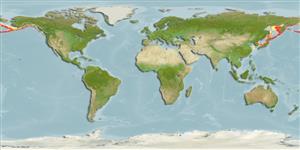Environment: milieu / climate zone / depth range / distribution range
Écologie
marin démersal; profondeur 20 - 830 m (Ref. 50610), usually 200 - 400 m (Ref. 56464). Temperate; ? - 4°C (Ref. 56464)
Northwest Pacific: Sea of Okhotsk to Kamchatka.
Taille / Poids / Âge
Maturity: Lm ? range ? - ? cm
Max length : 79.0 cm TL mâle / non sexé; (Ref. 56464); common length : 51.6 cm TL mâle / non sexé; (Ref. 56464); poids max. publié: 3.3 kg (Ref. 56464); âge max. reporté: 13 années (Ref. 56464)
Description synthétique
Clés d'identification | Morphologie | Morphométrie
Épines dorsales (Total) : 0; Rayons mous dorsaux (Total) : 96 - 100; Épines anales: 0; Rayons mous anaux: 81 - 87; Vertèbres: 101 - 109. Wide, blackish-brown blotches, about 10 in number on body; a narrow white band connecting upper ends of gill openings; ventral surface of head including lips, lower 1/2 of pectoral fin, and ventral 1/2 of body light (Ref.559). Lateral line ventral (Ref. 559).
Life cycle and mating behavior
Maturities | Reproduction | Spawnings | Egg(s) | Fecundities | Larves
Masuda, H., K. Amaoka, C. Araga, T. Uyeno and T. Yoshino, 1984. The fishes of the Japanese Archipelago. Vol. 1. Tokai University Press, Tokyo, Japan. 437 p. (text). (Ref. 559)
Statut dans la liste rouge de l'IUCN (Ref. 130435)
Menace pour l'homme
Harmless
Utilisations par l'homme
Pêcheries: d'intérêt potentiel
Outils
Articles particuliers
Télécharger en XML
Sources Internet
Estimates based on models
Preferred temperature (Ref.
123201): 0.5 - 4.1, mean 1.5 °C (based on 203 cells).
Phylogenetic diversity index (Ref.
82804): PD
50 = 0.5000 [Uniqueness, from 0.5 = low to 2.0 = high].
Bayesian length-weight: a=0.00269 (0.00174 - 0.00417), b=3.21 (3.08 - 3.34), in cm total length, based on LWR estimates for this species & Genus-body shape (Ref.
93245).
Niveau trophique (Ref.
69278): 3.3 ±0.3 se; based on diet studies.
Résilience (Ref.
120179): Très faible, temps minimum de doublement de population supérieur à 14 ans (Preliminary K or Fecundity.).
Fishing Vulnerability (Ref.
59153): Moderate to high vulnerability (52 of 100).
